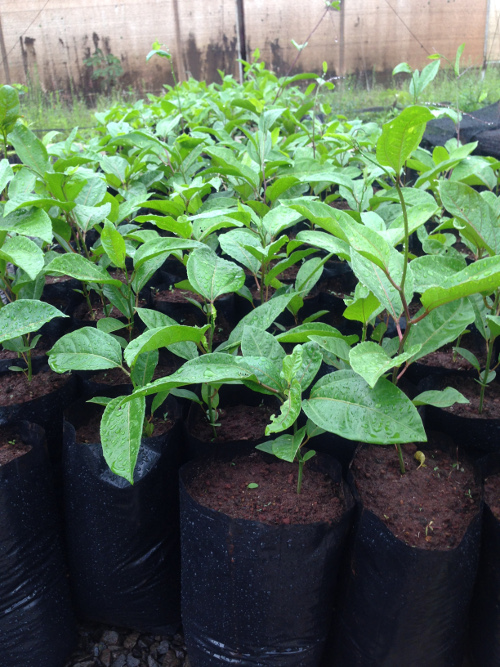Development and root morphology of passion fruit in different substrates

Abstract
Among the factors that contribute to better initial development of plants, it is the substrate used. Therefore, this study aimed to evaluate the effect of substrate in initial formation and morphology of the roots of two species of passion fruits. The analyses were done in the nursery of the Federal University of Goiás (UFG), Regional Jataí, Brazil, with a light interception of 60%. The material used were seeds of yellow passion fruit (Passiflora edulis f. flavicarpa) and the cultivar FB 200 (Flora Brasil), harvested in the UFG experimental field. They were sown in three types of substrates: Soil I (mixture of soil, chicken manure and sand in a ratio of 2:1:1 by volume), soil II (steep bank), and Bioplant®, using for plants perforated bags with a capacity of 1.5 L. The experimental design was a completely randomized design with six treatments, eight replications and four plants per plot. After 30 days of sowing, fresh matter of root, root dry matter and morphology were evaluated. The substrate affected the initial development of yellow passion fruit, obtaining the best results with Bioplant®, showing as promising for the development of all the evaluated characteristics.
Keywords
Passiflora edulis f. flavicarpa, Growth, Propagation, Fruit crops, Obtaining of seedlings
Author Biography
Pedro Henrique Magalhães de Souza
Universidad Federal de Goias
Alejandro Hurtado-Salazar
Departamento de Producción Agropecuaria
Danielle Fabíola Pereira da Silva
Departamento de Agronomia
Professor
References
- Almeida, M.O., M.C.M. Cruz, G.D.M. Castro, and M.C.P. Fagundes. 2014. Crescimento e absorção de nutrientes por mudas de maracujazeiro-amarelo em substratos orgânico e comercial e adubação nitrogenada. Rev. Bras. Ciênc. Agrar. 9(2), 180-185.
- Alves, E.U., S.S.S. Moura, M.F. Moura, R.S. Guedes, and F.A. Estrela. 2012. Germinação e vigor de sementes de Crateavatapia L. em diferentes substratos e temperaturas. Rev. Bras. Frutic. 34(4), 1208-1215. Doi: 10.1590/S0100-29452012000400030
- Borges, K., D. Santana, S. Lopes, and V. Pereira. 2016. Coloração do fruto e substrato na emergência e no crescimento de plantas de Eugenia calycinas Cambess. Floresta Ambient. 23(4), 544-554. Doi: 10.1590/2179-8087.144215
- Dutra, T.R., P.H. Grazziotti, R.C. Santana, and M.D. Massad. 2012. Desenvolvimento inicial de mudas de copaíba sob diferentes níveis de sombreamento e substratos. Rev. Ciênc. Agron. 43(2), 321-329. Doi: 10.1590/S1806-66902012000200015
- Ferreira, M.G.R., R.B. Rocha, E.P. Gonçalves, E.U. Alves, and G.D. Ribeiro. 2009. Influência do substrato no crescimento de mudas de cupuaçu (Theobroma grandiflorum Schum.). Acta Sci. Agron. 31(4), 677-681.
- Gomes, F.P. 2000. Curso de estatística experimental. 14th ed. ESALQ/USP, Piracicaba-SP, Brazil.
- Guerra, M.S., M.S. Barbosa, E. Costa, G. Haralampidou, and C. Vieira. 2017. Recipiente biodegradável e substratos para mudas de maracujazeiro, Rev. Agric. Neotrop. 4(3), 50-54.
- Lenhard, N.R., V.B. de Paiva Neto, S.P.Q. Scalon, and A.A. Alvarenga. 2013. Crescimento de mudas de pau-ferro sob diferentes níveis de sombreamento. Pesq. Agro. Trop. 43(2) 178-186. Doi: 10.1590/S1983-40632013000200012
- Leonel, S. and C.J. Pedroso. 2005. Produção de mudas de maracujazeiro doce com o uso de biorregulador. Rev. Bras. Frutic. 27(1), 107-109. Doi: 10.1590/S0100-29452005000100029
- Lima, I.M.O., J.S. Silva Júnior, E. Costa, E.D. Cardoso, F.F.S. Binotti, and M.H.A. Jorge. 2016. Diferentes substratos e ambientes protegidos para o crescimento de mudas de maracujazeiro amarelo doce. Rev. Agric. Neotrop. 3(4), 39-47.
- Meletti, L.M.M. 2011. Avanços na cultura do maracujá no Brasil. Rev. Bras. Frutic. 33(1), 83-90. Doi: 10.1590/S0100-29452011000500012
- Miyake, R.T.M., J.E. Creste, N. Narita, and W.E.X. Guerra. 2017. Substrato e adubação nitrogenada na produção de mudas de maracujazeiro amarelo em condições protegidas. Colloq. Agrar. 13(1), 57-65. Doi: 10.5747/ca.2017.v13.n1.a149
- Nakagawa, J. 1999. Testes de vigor baseados na avaliação dasplântulas. pp. 49-86. In: Vieira, R.D. and N.M. Carvalho (eds.). Testes de vigor em sementes. FUNEP, Jaboticabal-SP, Brazil.
- Negreiros, J., V.S. Álvares, L.R. Braga, and C.H. Bruckner. 2004. Diferentes substratos na formação de mudas de maracujazeiro-amarelo. Ver. Ceres, 51(294), 243-249.
- Roncatto, G., G.C. Nogueira Filho, C. Ruggiero, J.C. Oliveira, and A.B.G. Martins. 2008. Enraizamento de estacas herbáceas de diferentes espécies de maracujazeiro. Rev. Bras. Frutic. 30(4), 1094-1099. Doi: 10.1590/S0100-29452008000400041
- Silva, W.L., A.S. Brito, C.F.B. Brito, N.L.S. Mesquita, and Y.C.P. Silva. 2016. Desenvolvimento de maracujazeiro em recipientes e substratos a base de resíduo de vermiculita. Agrotec. 7(1), 53-60. Doi: 10.12971/2179-5959/agrotecnologia.v7n2p53-60
- Smiderle, O.S. and K. Minami. 2001. Emergência e vigor de plântulas de goiabeira em diferentes substratos. Rev. Cienc. Rur. 6(1), 38-45.
- Statistical Analysis System. 2002. SAS Institute, Cary, NC.
- Zaccheo, P.V.C., R.S. Aguiar, N.M.C. Stenzel, and C.S.V.J. Nevez. 2013. Tamanho de recipientes e tempo de formação de mudas no desenvolvimento e produção de maracujazeiro-amarelo. Rev. Bras. Frutic. 35(2), 603-607. Doi: 10.1590/S0100-29452013000200032
- Zucareli, V., O.E. Orika, C.S.F. Boaro, and W.P. Brambilla. 2014. Desenvolvimento inicial de maracujazeiros (Passiflora edulis f. flavicarpa, P. edulis f. edulis e P. alata) enxertados sobre Passiflora cincinnata. Ciên. Agrar. 35(5), 2325-2340.
